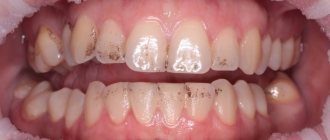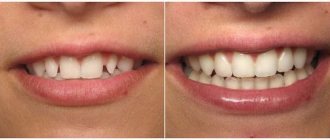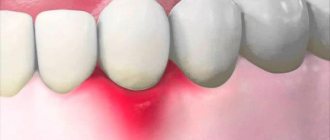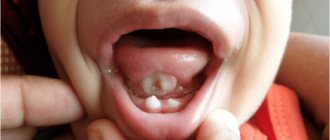The problem of food getting between teeth is one of the most common in dentistry. Most people, immediately after eating, need to thoroughly clean the interdental spaces with floss or a toothpick, since food debris getting between the teeth causes very unpleasant and even painful sensations.
Unfortunately, many take this situation for granted and continue to try to eliminate the discomfort without trying to identify and eliminate its cause. But it’s worth thinking about why pieces of food get stuck between the teeth and what the consequences might be; moreover, it’s necessary to take measures to solve the problem. This situation can be corrected quite easily; all you need to do is contact a qualified dentist.
What should you do if food gets stuck between your teeth regularly? The problem can be solved in two ways: by visiting the dentist to identify and eliminate the causes of this phenomenon, and by daily cleaning of the interdental space to prevent the proliferation of pathogenic bacteria.
Causes of food getting stuck between teeth
The main reason for food getting between the teeth is a violation of the density of their contact with each other (in dentistry this concept is referred to as a “contact point”), which can be caused by:
- low-quality fillings (prostheses). An incorrectly placed filling may not exactly follow the topography of the tooth and may have an overhanging edge. A sign of poor quality fillings can be either stuck food or breaks in the dental floss during its use;
- natural structure of the dentition. This may be curvature of the teeth, diastema (gaps between the lower or upper central teeth), trema (gaps between the lateral teeth);
- deformation of the dentition due to injury, tooth extraction, and various diseases of the oral cavity.
- Unprofessional prosthetics. There may be a gap between the crown and the tooth; the denture design does not correspond to the anatomical shape.
- There is no papilla between the tooth and gum. It fills the interdental space, and in the absence of such a papilla, the problem of food getting stuck appears.
- Crevices. May appear as a result of injuries or diastema. As a result, pieces of hard food constantly get stuck in the cracks, which have to be removed with thread or a toothpick.
- Loss of teeth. As a result, the integrity of the dentition is compromised, which provokes the occurrence of the problem in question;
- Caries. As a result of carious lesions, the enamel is destroyed and a cavity is formed. Residues of food accumulate here, which can only be removed purposefully: ordinary rinsing and salivation will not cope with this task.
How to fix it?
Methods for eliminating dental problems are selected based on the causative factor. So, if the culprit is an incorrectly made seal, it is changed and the contact points are carefully restored. Successful restorations are ground and checked to see if there are any overhanging edges that put pressure on the periodontal papilla or gum. In addition, professional oral hygiene is recommended with special emphasis on the problem area. This will improve the health of the gums and cleanse the tooth of accumulated deposits.
Consequences of regularly getting food stuck between teeth
Some people don’t even think about how to get stuck food out of their teeth. They are guided by the principle, it doesn’t hurt and it’s okay, making a big mistake. Meanwhile, such neglect can lead to dire consequences. For example:
- Gum diseases - food debris is an irritant that damages the mucous membranes, which provokes the development of dental diseases: gingivitis, periodontitis, etc.;
- Unpleasant odor - the food remaining between the teeth begins to decompose, which, in addition to the amber, creates a favorable environment for the life of pathogenic bacteria;
- Root injury – irritation of the gums can cause exposure of the neck of the tooth, which increases sensitivity and causes pain;
- Caries - stuck pieces of food is one of the main causes of carious lesions of the enamel; this disease can only be eliminated through dental intervention;
- Tissue destruction – if you do not clean the interdental space, the teeth begin to gradually deteriorate, which can lead to complete loss.
Tooth canal treatment with a microscope
Dentist-endodontist T.I. Matienko removed the old filling, removed the pin and washed the tooth canals. Cleaning of the canals is carried out under a microscope, using special endodontic instruments that penetrate into the narrowest parts of the canals. The tooth canal is washed with antimicrobial agents, and then medicine is placed into the canal to completely destroy the bacteria. The tooth is closed with a temporary filling for 14 days.
During the second visit to the endodontist, the filling was removed, the canal was again washed and dried, and then sealed with gutta-percha along its entire length. Since the tooth on top was badly damaged, a fiberglass pin was installed in it to strengthen it, and then the cavity in the tooth was closed with a light-rejecting filling made from the most modern Estelite material.
A filling is only an intermediate stage in tooth restoration. Next, an orthopedic dentist worked with the patient.
How to remove food if it's stuck between teeth
If food gets stuck between your teeth and your breath smells, you need to use hygiene products to care for your teeth.
The most common cleaning methods:
- The toothpick should be positioned at an angle of 30-40 degrees relative to the gum, pressed against the gingival papilla and the plane of the tooth. Remains of food are removed by moving the toothpick upward.
- Dental floss. The floss is pinched with your fingers and inserted into the interdental space. Cleaning with dental floss is carried out in a reciprocating motion.
It is important to understand here that both of these methods are quite traumatic, and any careless movement can damage the gums. Then how to remove food stuck between teeth? To do this, you can use an irrigator.
Irrigators are absolutely safe to use: pieces of stuck food are removed with a stream of water. This allows you to efficiently clean even hard-to-reach places without damaging the gums and interdental spaces. In addition, irrigators are ideal for the care of denture structures.
Recommendations
First of all, take good care of your mouth. When the first signs of food stuck appear, we recommend contacting your dentist for specialist advice. Don't forget to go to the prof 2 times a year. inspections. During a consultation with our specialists, you can find out which teeth should be treated and which fillings need to be replaced with new ones. You also need to come for professional teeth cleaning twice a year.
Secondly, we recommend contacting only trusted clinics with many years of history and experienced doctors. We would like to warn you against the temptation to use free dentistry under compulsory medical insurance; remember, good treatment and prosthetics cannot be free. Don't skimp on your health!
We hope that our article helped you and you found answers to your questions. If you have any further questions or would like to make an appointment, there is an appointment form below.
Why does food get caught under a denture?
If a crown or removable jaw is installed correctly, patients can easily adapt to it within a few weeks. Such prostheses restore the ability to smile and talk without embarrassment. But their main function is the complete chewing of solid foods, the opportunity to try new dishes and enjoy their favorite tastes. If food gets under your dentures, you should contact your dentist. This will help prevent inflammation of the gums or bad breath, and stop further destruction of the structure.
Main features
The destruction process takes a certain period of time. At the initial stage, the patient may notice and feel practically nothing. But the more the destruction spreads, the stronger the characteristic symptoms will appear.
The most basic signs of the disease are:
- Foul odor from the mouth. The rotting process is the main factor in the appearance of this smell. Even if a person does not feel it himself, it becomes immediately noticeable to others;
- Feeling of food debris getting stuck under the crown . The more the fixation of the prosthesis is disrupted, the more food gets inside;
- Color change. If you look closely, you can see darkening in the space between the gum and the crown. When severely damaged, it becomes almost black;
- Painful sensations. At the beginning of tooth decay, pain is completely absent. Before installing the prosthesis, the nerves are completely removed. But as the tooth decays, gum inflammation may begin. In this case, pain may occur.
If such symptoms appear, you should immediately consult a doctor. Tooth decay requires appropriate treatment. Otherwise, it may lead to serious complications .
Dental scanning and dental crown modeling
Before modeling the new crowns, a teeth scan was performed. Dental scanning replaces traditional dental impressions, which many patients cannot tolerate due to an increased gag reflex. When taking digital impressions of teeth, the dentist runs a Sirona scanner along the surfaces of the teeth for several minutes, and a three-dimensional image of both jaws is transferred to the computer - a digital impression of the teeth.
Working with a digital impression in a specialized program, the dentist models crowns with the most tight contacts between the teeth and the correct anatomical chewing surface.
Based on the simulation results, the dental technician produced ceramic crowns from E.max ceramics. Pressed ceramics E.max has high strength and excellent aesthetic properties, therefore it is used for prosthetics of both lateral and anterior teeth.
Reviews
The appearance of an unpleasant odor from under the crown is one of the most common problems after the prosthetic procedure.
The experience of other people can help you avoid such troubles and mentally prepare for different situations.
In the comments to this article, everyone can leave their feedback and share their opinion or experience in eliminating unpleasant odor from under an artificial crown.
Did you like the article? stay tuned
The result of replacing crowns is that food does not get stuck between the teeth
Tight contacts between teeth ensure that food does not get stuck and gums remain healthy.
The cost of ceramic crowns is 55,000 rubles per unit.
Of course, it is possible to make dental crowns cheaper (cheaper material, lack of computer modeling, etc.), but this will invariably affect the quality. The use of computer technology makes it possible to more carefully work out the shape of the crowns, provides additional convenience when taking impressions - all this is reflected in the price, so good dental crowns cannot be cheap. In addition, Dial-Dent uses the highest quality and most modern materials both for the crowns themselves and for their fixation, which increases the service life of dental restorations.
Video about how teeth are scanned with an intraoral scanner:
How to determine that a denture has a bad effect on the microflora of the oral cavity?
It has been proven that the prosthesis and prosthetic material negatively affect the oral mucosa, as well as numerous elements of its homeostasis.
Dentists consider the subjective complaints of patients to be the main criterion for the influence of a design. Often, denture owners complain of symptoms such as:
- dry mouth;
- continuous burning;
- changes in the usual tastes of foods.
When choosing dentures, the dentist is based on the characteristics of the defects in the dentition and the condition of the remaining teeth. But, unfortunately, doctors very rarely take into account the condition of the mucous membrane itself and its microflora, although they know that the degree of sedimentation of microorganisms on prosthetic materials can vary significantly.
The work of the salivary glands also changes under the influence of dentures:
- the intensity of salivation changes (its sharp decrease is observed);
- the concentration in saliva of total protein, sodium, potassium, as well as biogenic amines decreases;
- lipid peroxidation is activated;
- The protective capabilities of saliva are significantly reduced.
Removable dentures often cause significant dysbiosis in the oral cavity, creating favorable conditions for many pathogenic microorganisms. For example, several years ago scientists discovered such microorganisms under plate structures as:
- enterococcus;
- non-hemolytic streptococcus;
- diplococcus;
- pathogenic staphylococcus;
- gram-positive rods;
- mushrooms of the genus Candida;
- lactobacilli.
As we have already said, most often pathological reproduction of Candida fungi occurs due to a decrease in the body’s immune defense and further colonization of the entire mucous membrane by fungi. While salivation decreases, the number of fungi increases, the microbial balance of the oral cavity changes, which often leads to the development of various types of inflammation of the tissues of the prosthetic bed.
Microorganisms release waste products, and lipid peroxidation processes are activated. Toxic elements increase inflammation and pain reactions and can ultimately cause tissue atrophy.
Common types of prostheses
A large number of techniques and methods are used to restore teeth in dentistry. With their help, an experienced prosthetist can insert one destroyed unit and form a beautiful bridge with the loss of several teeth. All dentures are divided into removable and non-removable. The first ones are attached with miniature locks and fasteners and can be easily removed for daily cleaning. The latter are fixed securely with a special glue or cement, reminiscent of a filling composition.
You can restore the ability to chew by installing one of the following dentures:
- crowns, which are tightly fixed to the tooth stump;
- clasp or soft acrylic bridge;
- false jaws with a special fastening system with locks or suction cups;
- temporary plastic overlays that must be worn before implantation and cover the implanted pins.
The design should fit so tightly to the gums as to prevent the ingress of plaque and pieces of food.
When wearing, it is necessary to avoid chafing and dents, pain and discomfort. If food becomes trapped under the denture, rotting and decomposition occurs. This provokes a specific smell when talking and the appearance of inflammation of the mucous membrane, provokes the development of chronic gingivitis and periodontal disease. The diseases also affect healthy teeth and cause damage to the roots, pulpitis and dangerous abscesses in the periodontium. Another common complication occurs if food gets caught under a fixed denture. Once the crown is cemented in place, it cannot be removed for proper cleaning. Gradually, plaque after eating is fixed on the enamel of the remaining stump, turns into stone, eats away at it and leads to secondary caries.
Characteristic signs of pathology
It is easy to detect an unpleasant odor. If the patient himself does not feel it, then those around him and close people can tell him this. It can vary in intensity, but generally feels quite good. Characteristic features:
- persistent, unpleasant, rotten odor from the mouth;
- feeling of food debris under the crown;
- darkening under the crown is visually observed (this is how tooth decay is determined when it turns black).
In most cases, the patient can independently determine the cause of this pathology, but only a dentist can eliminate it. It is worth choosing an experienced and responsible doctor to avoid poor-quality treatment.
Causes of inflammation when wearing dentures
The most common causes of so-called prosthetic stomatitis, inflammation in the oral cavity, doctors call mechanical herbs and allergies. This unpleasant disease is caused by yeast-like candida fungi, the reproduction of which is provoked precisely by wearing the structure. The body reacts to the accumulation of microbes with “prosthetic plaques”, which increasingly appear on the elements of the product itself.
According to dentists, the incidence of denture stomatitis varies from 27 to 68%. Patients wearing such structures often complain of dry mouth, burning, unpleasant taste of food and inflammation of the mucous membranes.
Another common cause of such complaints are various types of allergic reactions that occur due to the interaction of acrylic plastic or metals with various food products.
The increase in the number of Candida fungi is also influenced by factors such as:
- eating disorders;
- diabetes;
- xerostomia (decreased salivation);
- immunosuppression (suppression of immunity).
The state of the oral microflora is also influenced by local factors such as mechanical injuries and the level of hygiene. Carbohydrates provide additional nutrition for Candida mushrooms. Therefore, people wearing dentures should be especially careful when using them.
We should also not forget that candida fungi are often released not only from the mucous membrane, but also from the dentures themselves. When wearing structures, they must be treated with special anti-candidiasis drugs to remove and stop the proliferation of microbes.
Odor from under the crown, effective elimination methods, causes and prevention
The smell from under the crown often occurs due to poorly installed construction. Remains of food get under the crown, causing them to fester. This causes an unpleasant odor. Soft tissues are damaged, in which serious diseases can develop. To solve the problem and identify its cause, you need to contact your dentist.
Patient Actions
It is important to understand that tooth decay is an irreversible process . If left untreated for a long time, the situation can worsen significantly. The process of putrefaction will progress successfully. In most cases, it spreads into soft tissues and causes severe complications.
If you experience an unpleasant odor, you should contact your dentist as soon as possible. He removes the denture and assesses the condition of the tooth. The crown requires cleaning and checking for tightness of fixation. If you do not see a doctor in time, you will not be able to save the tooth. An implant will have to be installed in its place. In addition, it is important to save not only the tooth, but also the tissues that surround it.










